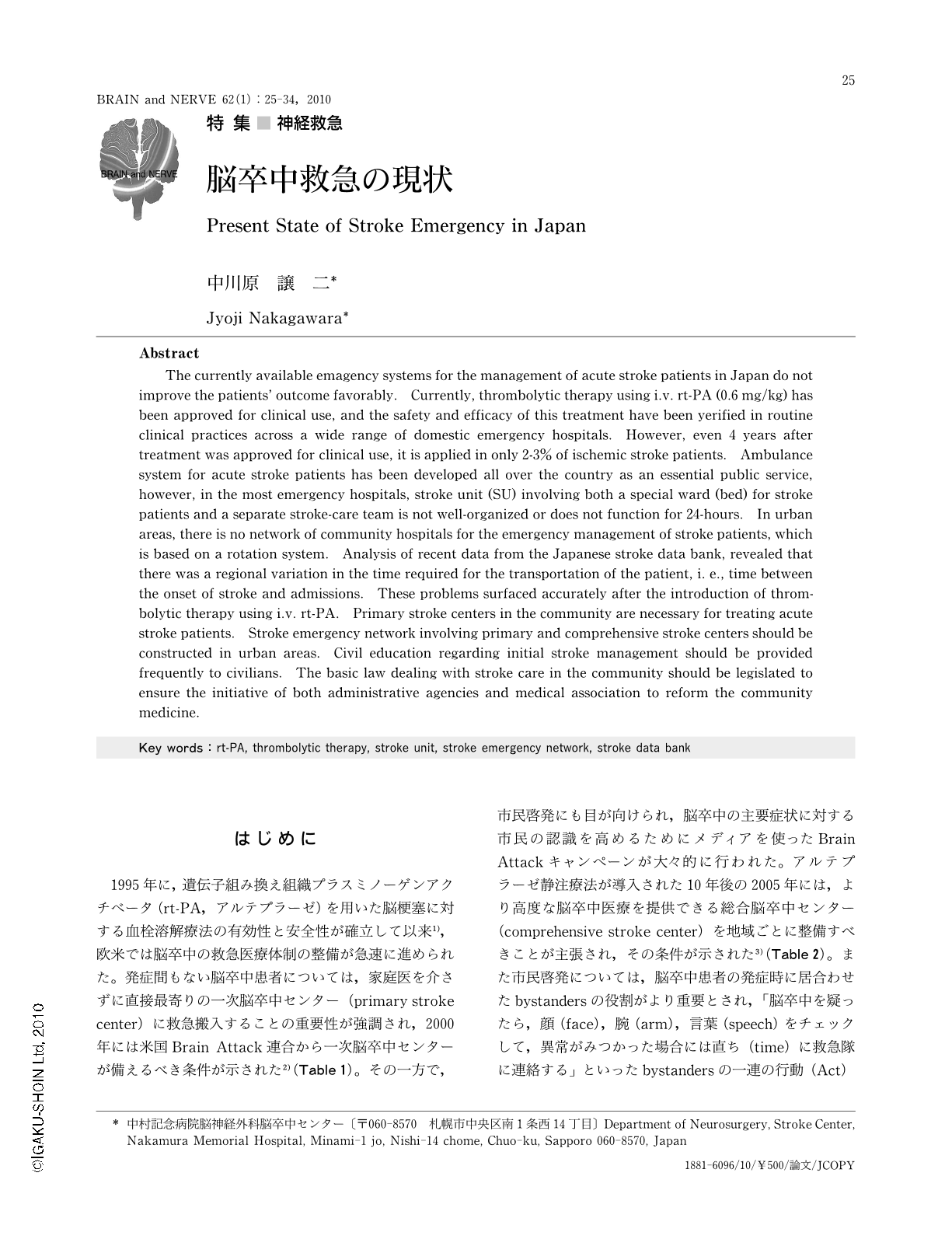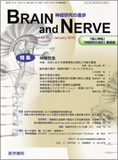Japanese
English
- 有料閲覧
- Abstract 文献概要
- 1ページ目 Look Inside
- 参考文献 Reference
はじめに
1995年に,遺伝子組み換え組織プラスミノーゲンアクチベータ(rt-PA,アルテプラーゼ)を用いた脳梗塞に対する血栓溶解療法の有効性と安全性が確立して以来1),欧米では脳卒中の救急医療体制の整備が急速に進められた。発症間もない脳卒中患者については,家庭医を介さずに直接最寄りの一次脳卒中センター(primary stroke center)に救急搬入することの重要性が強調され,2000年には米国Brain Attack連合から一次脳卒中センターが備えるべき条件が示された2)(Table1)。その一方で,市民啓発にも目が向けられ,脳卒中の主要症状に対する市民の認識を高めるためにメディアを使ったBrain Attackキャンペーンが大々的に行われた。アルテプラーゼ静注療法が導入された10年後の2005年には,より高度な脳卒中医療を提供できる総合脳卒中センター(comprehensive stroke center)を地域ごとに整備すべきことが主張され,その条件が示された3)(Table2)。また市民啓発については,脳卒中患者の発症時に居合わせたbystandersの役割がより重要とされ,「脳卒中を疑ったら,顔(face),腕(arm),言葉(speech)をチェックして,異常がみつかった場合には直ち(time)に救急隊に連絡する」といったbystandersの一連の行動(Act)を,それらの頭文字を繋いで「Act-FAST」と命名し,メディアを使った啓発が開始されている。
わが国では,米国から遅れること10年,2005年10月にアルテプラーゼ静注療法が保険診療として承認された。アルテプラーゼ静注療法の開始にあたっては,日本脳卒中学会が適正治療指針を作成し4),適正使用講習会が全国で実施された。しかしながら,患者の受け入れ先である一次脳卒中センターの整備や市民啓発は必ずしも進展していない。急性期脳梗塞患者の30%が3時間以内に病院に搬入されている現状において,アルテプラーゼ静注療法が脳梗塞急性期患者の2~3%にとどまっているのは,搬入先の病院が24時間体制で機能していないことを示唆している。また,アルテプラーゼ静注療法の施行率には都市部と郡部との間の格差だけでなく,全国を9ブロックで分けた地区別でも格差がみられ(Fig.1),脳卒中救急医療の国内均霑化が大きな課題となっている。
本稿では,アルテプラーゼ静注療法の使用成績の現状,Stroke Unitの設置状況からみた脳卒中診療体制の現状,脳卒中救急医療連携(前方連携)の現状,脳卒中データバンクによる脳卒中患者の入院までの時間に関する分析などから,日本の脳卒中救急の現状について述べる。
Abstract
The currently available emagency systems for the management of acute stroke patients in Japan do not improve the patients' outcome favorably. Currently,thrombolytic therapy using i.v. rt-PA (0.6 mg/kg) has been approved for clinical use,and the safety and efficacy of this treatment have been yerified in routine clinical practices across a wide range of domestic emergency hospitals. However,even 4 years after treatment was approved for clinical use,it is applied in only 2-3% of ischemic stroke patients. Ambulance system for acute stroke patients has been developed all over the country as an essential public service,however,in the most emergency hospitals,stroke unit (SU) involving both a special ward (bed) for stroke patients and a separate stroke-care team is not well-organized or does not function for 24-hours. In urban areas,there is no network of community hospitals for the emergency management of stroke patients,which is based on a rotation system. Analysis of recent data from the Japanese stroke data bank,revealed that there was a regional variation in the time required for the transportation of the patient,i. e.,time between the onset of stroke and admissions. These problems surfaced accurately after the introduction of thrombolytic therapy using i.v. rt-PA. Primary stroke centers in the community are necessary for treating acute stroke patients. Stroke emergency network involving primary and comprehensive stroke centers should be constructed in urban areas. Civil education regarding initial stroke management should be provided frequently to civilians. The basic law dealing with stroke care in the community should be legislated to ensure the initiative of both administrative agencies and medical association to reform the community medicine.

Copyright © 2010, Igaku-Shoin Ltd. All rights reserved.


